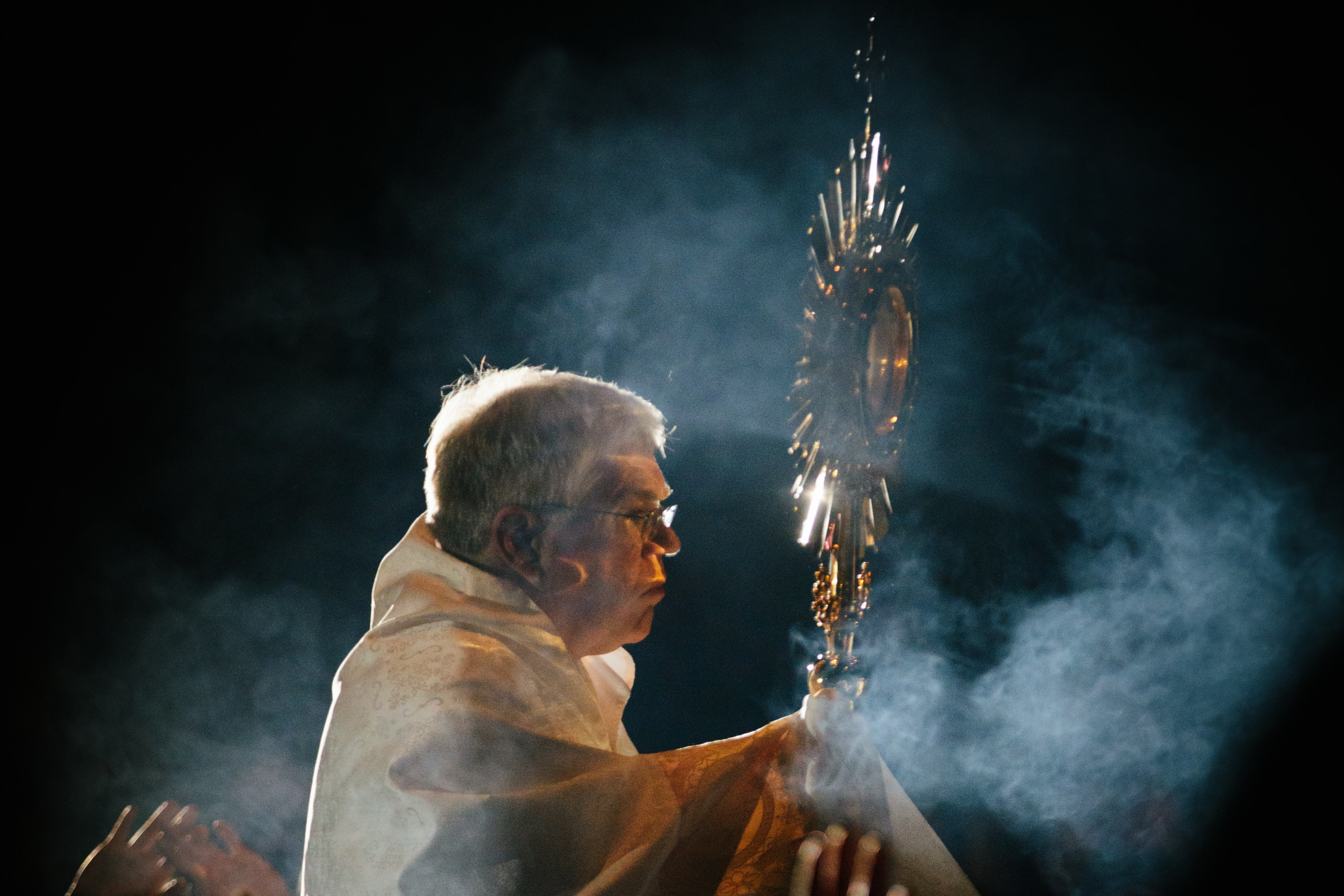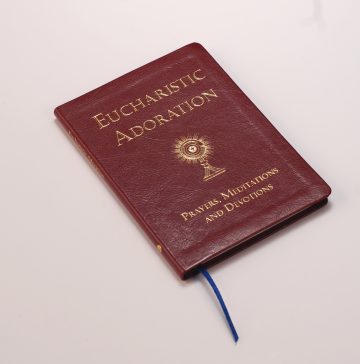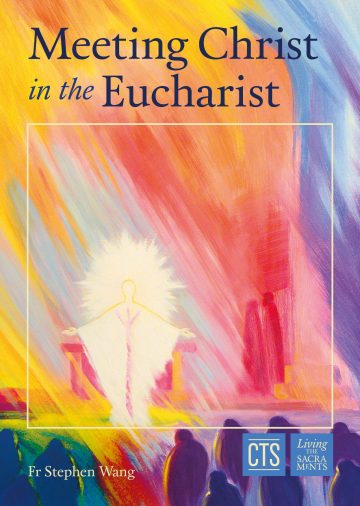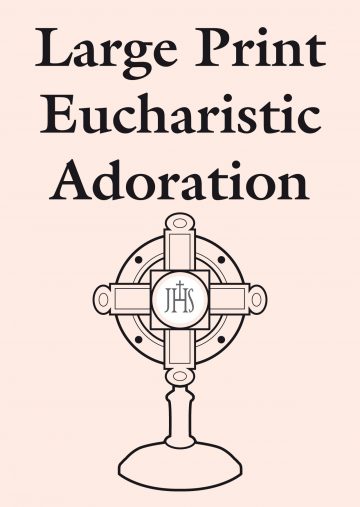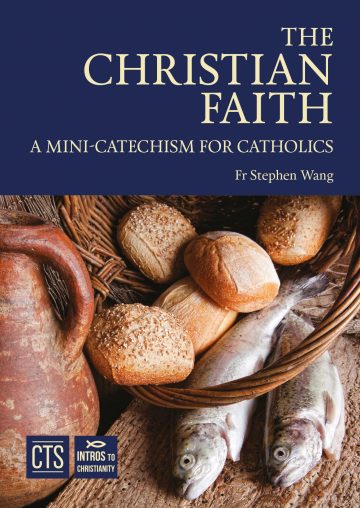Jesus Christ is present at the Mass in different ways: in the midst of the Christian community, when they gather to pray in his name; through his Word, when the Scriptures are proclaimed; and in the ministry of his priests, who act “in the person of Christ the head”. There is one way of being present, however, that is utterly unique and has a significance far beyond all the others: the Real Presence of Jesus Christ in the Eucharist.
We believe that Jesus Christ, true God and true man, is present in Holy Communion, under the appearances of bread and wine, in what is called the Blessed Sacrament. At every Mass, at the consecration, the bread and wine are changed into the Body and Blood of Christ through the power of the Holy Spirit. This is the miracle of transubstantiation. It’s why we teach children not to say “the bread” or “the wine” when speaking about Holy Communion, because something fundamental has changed.
This is not just a sign or a symbol or a memory. We encounter “the whole Christ” – Body, Blood, Soul and Divinity – heart to heart, face to face. He is here.
We believe that the Eucharist is food for our hungry souls; it is healing and forgiveness; it is love and friendship; it is a share in his holiness and a promise of eternal life; it is a communion with the Church which is his body; it is a union with our brothers and sisters spread throughout the world and throughout time.
We don’t always feel this or see it with our bodily eyes; but we can believe it, and see it with the eyes of faith. We believe this because of the words and the promises of Jesus. He himself said: “This is my body…this is my blood…”; “Anyone who eats my flesh and drinks my blood has eternal life”; “My flesh is real food and my blood is real drink.” We believe this because of the constant teaching of the Church over twenty centuries. And we believe this because of the witness of the saints, who became saints in part because they learned to love Jesus Christ in the Eucharist.
When St Claire of Assisi heard that Imperial troops were about to storm her city, she took the Blessed Sacrament to the window of her convent and prayed over the attacking armies. At the last minute, the power of her prayer and the power of the Sacrament miraculously turned them away. When St Margaret Mary Alacoque went to pray in front of the Blessed Sacrament in her convent in France, she had a vision of Jesus standing before her. His Sacred Heart was burning with love for her and for the whole of humanity, wounded by our sins and our lack of love, calling us to know him more, calling us to love him in the Blessed Sacrament.
Most of us, however, don’t see him in this way. We need faith. As Jesus said to St Thomas after the Resurrection: “Blessed are those who have not seen and yet believe.” And many people have an instinctive feeling for the holiness of our Catholic churches. They are sacred spaces because of the presence of the Blessed Sacrament in the tabernacle. People understand that something happens at the moment of consecration. They instinctively want to worship Christ, now present here at the altar, when the priest holds up the host and the chalice for adoration. They know that they can open their hearts to him in a very personal way, in repentance, trust, love and friendship, because of his loving presence.
Holy Scripture
For personal prayer, reflection and meditation
[On the road to Emmaus] “When Jesus was at the table with them, he took bread, blessed and broke it, and gave it to them. Then their eyes were opened, and they recognised him; and he vanished from their sight. They said to each other, ‘Were not our hearts burning within us while he was talking to us on the road, while he was opening the Scriptures to us?’” (Lk 24:30-32)
[St Paul writes] “The cup of blessing that we bless, is it not a sharing in the blood of Christ? The bread that we break, is it not a sharing in the body of Christ? Because there is one bread, we who are many are one body, for we all partake of the one bread.” (1 Co 10:16-17)
[St Paul writes] “For I received from the Lord what I also handed on to you, that the Lord Jesus on the night when he was betrayed took a loaf of bread, and when he had given thanks, he broke it and said, ‘This is my body that is for you. Do this in remembrance of me.’ In the same way he took the cup also, after supper, saying, ‘This cup is the new covenant in my blood. Do this, as often as you drink it, in remembrance of me.’ For as often as you eat this bread and drink the cup, you proclaim the Lord’s death until he comes.” (1 Co 11:23-26)
Key passages from the Catechism and other Church documents
CCC 1374: “The mode of Christ’s presence under the Eucharistic species is unique. It raises the Eucharist above all the sacraments as ‘the perfection of the spiritual life and the end to which all the sacraments tend.’ [St Thomas Aquinas, STh III, 73, 3c] In the most Blessed Sacrament of the Eucharist ‘the Body and Blood, together with the Soul and Divinity, of our Lord Jesus Christ and, therefore, the whole Christ is truly, really, and substantially contained.’ [Council of Trent (1551): DS 1651]”
CCC 1376: “The Council of Trent summarises the Catholic faith by declaring: ‘… by the consecration of the bread and wine there takes place a change of the whole substance of the bread into the substance of the Body of Christ our Lord and of the whole substance of the wine into the substance of his Blood. This change the holy Catholic Church has fittingly and properly called transubstantiation.’ [Council of Trent (1551): DS 1642; cf. Mt 26:26 ff.; Mk 14:22 ff.; Lk 22:19 ff.; 1 Co 11:24 ff.]”
CCC 1378: “‘The Catholic Church has always offered and still offers to the sacrament of the Eucharist the cult of adoration, not only during Mass, but also outside of it, reserving the consecrated hosts with the utmost care, exposing them to the solemn veneration of the faithful, and carrying them in procession.’ [Paul VI, MF 56]”
Presbyterorum Ordinis 5: “The Most Holy Eucharist contains the whole spiritual treasure of the Church, namely Christ himself, our Passover and our Living Bread”.
Wisdom from the saints
“You left us yourself in the Sacrament of the Altar, and you opened wide your mercy to us. There is no misery that could exhaust you. You have called us all to this fountain of love, to this spring of God’s compassion.” St Faustina
“If I can give you any advice, I beg you to get closer to the Eucharist and to Jesus… We must pray to Jesus to give us that tenderness of the Eucharist.” St Teresa of Calcutta
“Lord Jesus Christ, pierce my soul with your love so that I may always long for you alone, who are the bread of angels and the fulfilment of the soul’s deepest desires. May my heart always hunger for you, so that my soul may be filled with the sweetness of your presence.” St Bonaventure
“We adore you, most holy Lord Jesus Christ, here, and in all your churches throughout all the world; and we bless you, because, by your holy cross, you have redeemed the world.” St Francis of Assisi
“Many people nowadays say, ‘I wish I could see his shape, his appearance, his clothes, his sandals.’ Only look! You see him! You touch him! You eat him!” St John Chrysostom
Summary of core beliefs
• Jesus Christ is truly present in the Blessed Sacrament: the whole Christ – Body, Blood, Soul and Divinity.
• The bread and wine at Mass are changed into his Body and Blood through the miracle of transubstantiation, so that only the appearances and not the substance of bread and wine remain.
• We can worship Christ as God and Saviour in the Blessed Sacrament, and we can speak to him, heart to
heart, as a friend and brother.
Practical suggestions
• Remember to genuflect as you enter and leave your place at Mass, and be conscious that you are genuflecting to the presence of Christ in the tabernacle.
• If you are able, you can kneel in prayer and adoration before Mass (to worship Christ and prepare for the celebration) and after Mass in thanksgiving.
• Appreciate the many gestures we make during Mass and what they signify: standing, kneeling, sitting; bowing during the Creed and as we approach Holy Communion, etc.
• As far as possible, try to keep a reverent and prayerful silence in church, and avoid unnecessary chatter – in order to help you be more prayerful, and to help those around you to pray.
• Display an image of the Sacred Heart of Jesus in your home, to remind you of his loving presence wherever you are.
Prayer
Lord our God, in this great sacrament we come into the presence of Jesus Christ, your Son, born of the Virgin Mary and crucified for our salvation. May we who declare our faith in this fountain of love and mercy drink from it the water of everlasting life. We ask this through Christ our Lord.
R. Amen.
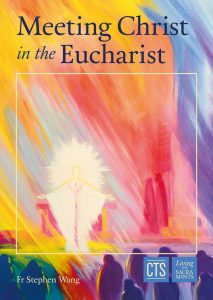 This blog is extracted from Meeting Christ in the Eucharist. Grow in love for Christ in the Eucharist with prayers, scripture readings, meditations, and quotations from the Catechism and from the saints, along with stunning art to aid personal reflection.
This blog is extracted from Meeting Christ in the Eucharist. Grow in love for Christ in the Eucharist with prayers, scripture readings, meditations, and quotations from the Catechism and from the saints, along with stunning art to aid personal reflection.
To learn more about the Eucharist, and to reflect upon these truths with the help of stunning Catholic art, order your copy of Meeting Christ in the Eucharist.
